10 Best Native Plants for Michigan
BY TATIANA BARRIE | MAY 14TH, 2023 | LAWN CARE, MICHIGANTired of out-of-state friends boasting about their lush gardens while your plants struggle with Michigan’s unpredictable weather? Here’s the solution: native plants. Michigan is home to a wide variety of native species that thrive in its unique climate. In this article, we’ll show you the best native plants for Michigan yards, whether you’re looking for vibrant and hardy wildflowers, shrubs, or trees.
Not only do native plants make your backyard look like a slice of Pure Michigan paradise super easily, but they also offer many benefits:
- Since they’re adapted to Michigan’s weather, they usually require less maintenance than non-native plants.
- They typically have built-in defenses against local pests, which means less need for pesticides.
- They bring a lot of biodiversity to your garden by providing food and shelter for pollinators like hummingbirds, butterflies, and bees.
Here’s what we’ll cover:
- 10 Native Plants for Your Michigan Yard
- How to Choose Native Plants for Your Michigan Landscape
- FAQ About Native Michigan Plants
- Where to Find Native Plants in Michigan
10 Native Plants for Your Michigan Yard
1. Common Buttonbush (Cephalanthus occidentalis)
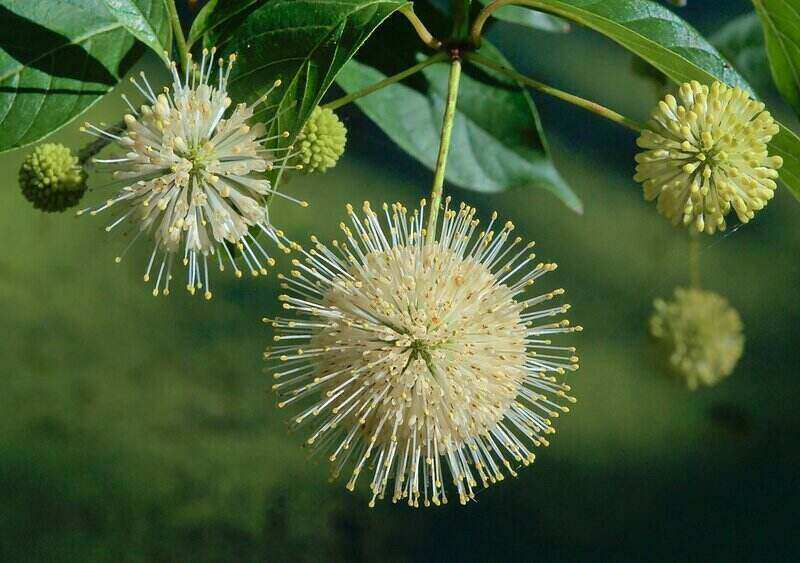
Photo Credit: The Cosmonaut / Wikimedia Commons / CC BY-SA 4.0
The common buttonbush is the perfect addition to any yard near one of Michigan’s lakes or rivers. If you’re nestled along the shores of Lake Superior in the Upper Peninsula, this shrub will have no trouble adapting to the cooler climate and thriving in the moist soil. If you live near the waters of Lake Michigan, such as in Grand Haven or Holland, this plant will also handle the region’s warmer temperatures with ease.
The common buttonbush is a real showstopper with its unique, spherical white flowers that bloom from June to September. It’s also super versatile and easy to care for. It can grow up to 12 feet tall, so you can place it in the back of a garden bed or as a standalone shrub. However, it may require regular pruning to maintain its shape and prevent it from becoming too large and unruly.
Plant type: Shrub
USDA Hardiness Zone: 5 to 11
Sun: Full sun to partial shade
Soil: Loam, sand
Duration: Perennial
Fragrance: Dried flowers and leaves smell like freshly-mown grass
Bloom time: June – September
Water needs: Medium to High
Mature height: 5 to 12 ft
Potential hazards: Poisonous to humans, pets, and other animals if ingested.
Maintenance: Low
2. Smooth Blue Aster (Symphyotrichum laeve)
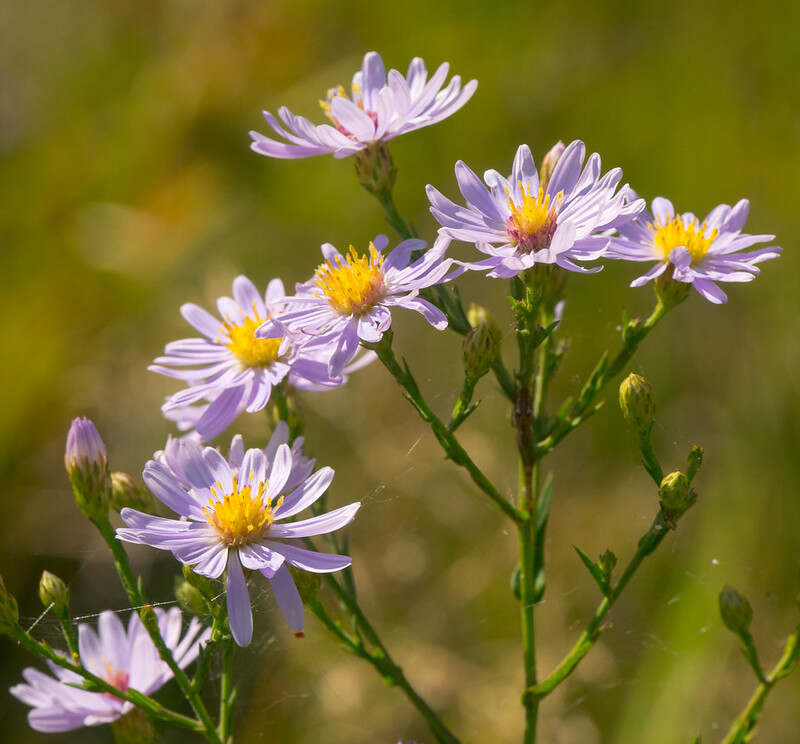
Photo Credit: Joshua Mayer / Flickr / CC BY-SA 2.0
Known for its stunning violet-blue flowers, which bloom from late summer to early fall, the smooth blue aster can be grown anywhere in Michigan. From the rocky soils of the Upper Peninsula to the sandy and loamy soils of the Lower Peninsula, this hardy plant can thrive in a range of environments. It can also adapt to different pH levels, from acidic to slightly alkaline conditions.
For the best flowering display, it’s recommended to provide at least 6 hours of direct sunlight per day, so avoid planting it under, so avoid planting it under dense shade or in areas with limited sun exposure. It’s also essential to plant it in an area with good air circulation. This will help prevent the buildup of moisture around the leaves, which can lead to fungal growth.
Plant type: Herb
USDA Hardiness Zone: 4 to 8
Sun: Full sun
Soil: Dry soils
Duration: Perennial
Fragrance: No fragrance
Bloom time: July – October
Water needs: Medium
Mature height: 2 to 4 feet
Maintenance: Medium
3. American Black Elderberry (Sambucus canadensis)
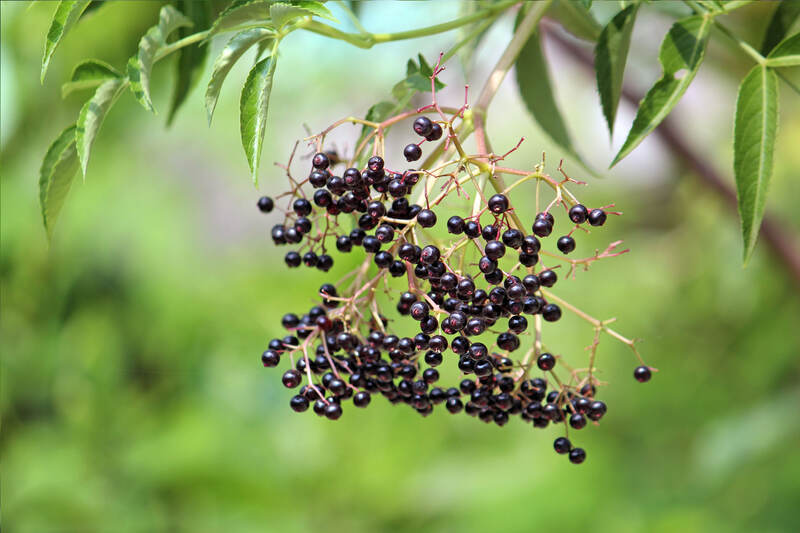
Photo Credit: Rison Thumboor / Wikimedia Commons / CC BY-SA 4.0
American Black Elderberry is a shrub that can grow up to 8 feet tall, with clusters of white flowers that bloom in early summer, followed by dark purple-black berries in late summer or early fall. It’s not only an attractive plant, but also a highly adaptable option. It doesn’t matter if you’re up north in Marquette dealing with colder temperatures or down in Ann Arbor enjoying milder conditions; this plant can thrive in both the Upper Peninsula and the Southern Lower Peninsula.
Plus, it’s not picky about soil, so whether you’ve got sandy soil near the Great Lakes shoreline or clay-rich dirt in the heart of Detroit, this plant will feel right at home. Plus, its ability to withstand drought and resist pests means it won’t require a lot of maintenance, making it a great choice for those who want to spend more time enjoying their garden than tending to it.
Plant type: Shrub
USDA Hardiness Zone: 4a to 10b
Sun: Full sun, part shade
Soil: Tolerates a wide variety of wet to dry soils but prefers rich, moist, slightly acid soil.
Duration: Perennial
Fragrance: Sweet
Bloom time (or season of interest, if it doesn’t bloom): May to July
Water needs: Medium
Mature height: 5 to 8 feet
Potential hazards: Raw fruit is inedible to people
Maintenance: Regular pruning to remove suckers from base of plant
4. New England Aster (Symphyotrichum novae-angliae)
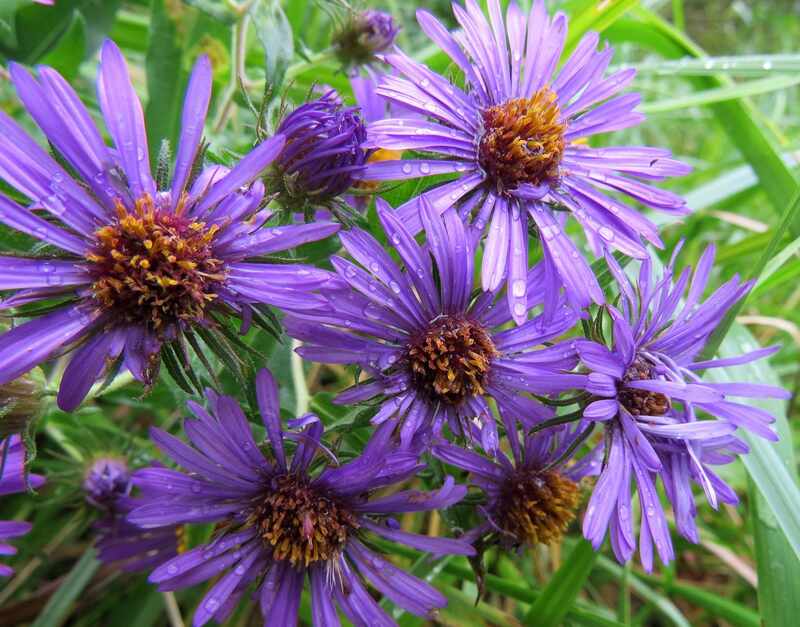
Photo Credit: USFWS Midwest Region / Flickr / Public Domain
The New England aster is most commonly found in the northern Lower Peninsula and the southern Lower Peninsula of Michigan. These regions’ well-drained sandy, loam, and clay-rich soils and moderate temperatures allow them to establish strong roots and produce abundant blooms.
It’s a tall, upright plant that typically grows to a height of 3 to 6 feet. Its leaves are lance-shaped and toothed, while its flowers are daisy-like and range in color from pink to purple to blue.
Generally, it’s a healthy, low-maintenance plant that’s not prone to many pests or diseases. However, it’s susceptible to Lygus bugs, so make sure to regularly inspect plants for signs of infestation and use insecticidal soaps, neem oil, or other natural pesticides to control them.
Plant type: Flower
USDA Hardiness Zone: 4 to 8
Sun: Full sun to partial shade
Soil: Clay, sandy, loamy
Duration: Perennial
Bloom time: Late summer – early fall
Water needs: Medium
Mature height: 3 to 6 feet
Maintenance: Medium
5. Showy Goldenrod (Solidago speciosa)
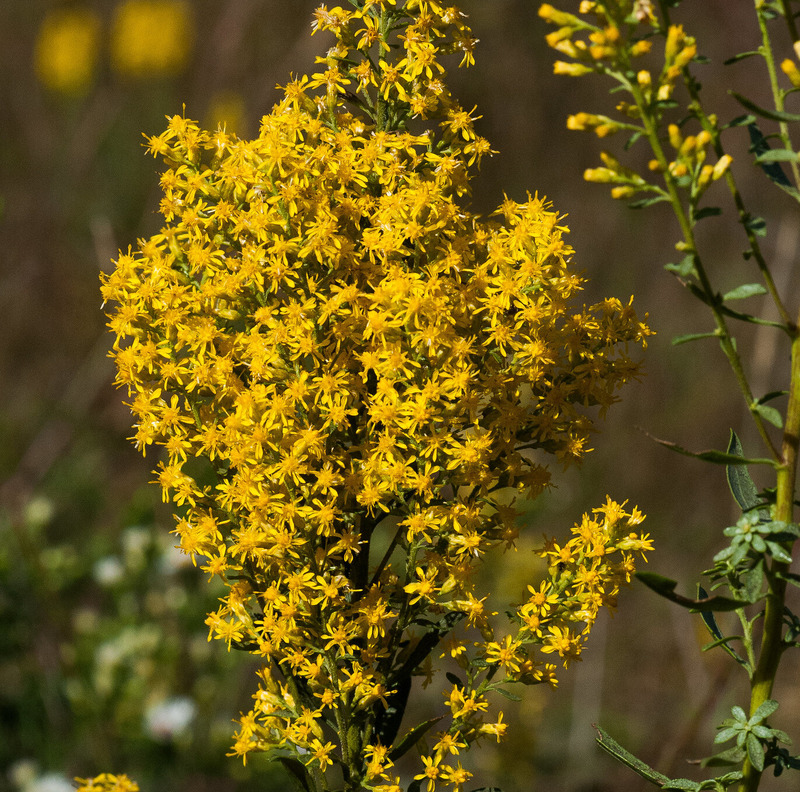
Photo Credit: Joshua Mayer / Flickr / CC BY-SA 2.0
Showy goldenrod is a versatile plant that can thrive in a variety of Michigan landscapes, but it’s particularly well-suited to the northern and southern regions of the Lower Peninsula. The area’s varied soil composition, ranging from the sandy dunes along the shoreline of Lake Michigan to the fertile loam in the inland areas is the perfect environment for this plant to grow.
Showy goldenrod is a low-maintenance plant that can grow up to 5 feet tall and is adorned with bright, golden-yellow flower clusters that bloom from late summer through fall. It’s also deer-resistant, which is a huge advantage if you live in cities with deer overpopulation problems, such as Ann Arbor or Lansing.
Plant type: Flower
Hardiness zones: 3a to 8b
Sun: Full sun, partial shade
Soil: Rocky, clay
Duration: Perennial
Fragrance: Mild
Bloom Time: July to September
Water needs: Low to medium
Mature height: 1 to 5 feet
Potential hazards: Medium flammability. Mildly poisonous to some herbivores.
Maintenance: Low to Medium; May have to divide it every 2 years for size management.
6. Common Boneset (Eupatorium perfoliatum)
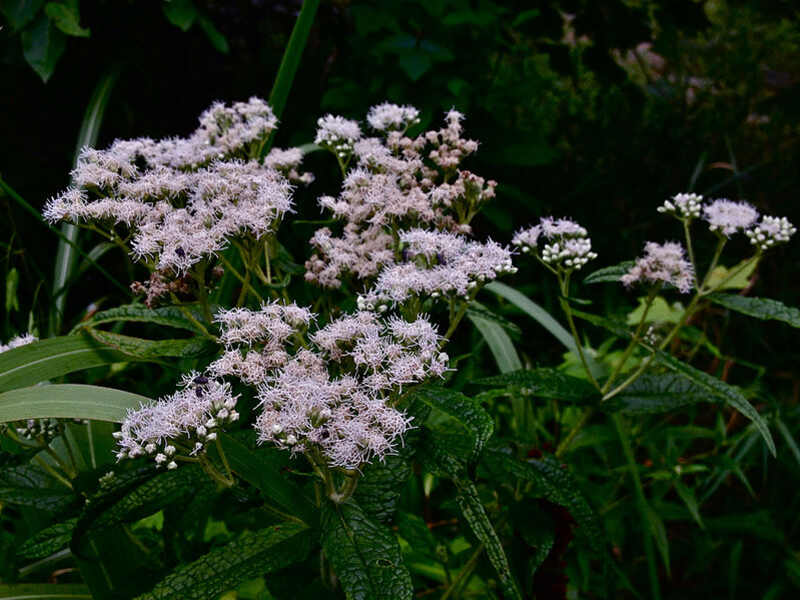
Photo Credit: Fritzflohrreynolds / Wikimedia Commons / CC BY-SA 3.0
Known for its clusters of tiny, white flowers, the common boneset is a great choice for gardens across the state. As long as the soil is moist enough and the plant receives enough sunlight (at least 4 hours), it can grow anywhere in Michigan.
The common boneset is a hardy wildflower that can handle various soil types, from sandy to clay. Plus, it has an extensive root system that contributes to soil stability and erosion prevention. Now, keep in mind that it can spread aggressively if not kept in check. Therefore, it’s important to monitor its growth and trim it back regularly to prevent it from becoming invasive.
Plant type: Flower
USDA Hardiness Zone: 3 to 9
Sun: Full sun to partial shade
Soil: Organic-rich moist to wet sandy or clay soils; though it can also tolerate dry soils.
Duration: Perennial
Fragrance: Sweet, floral scent
Bloom time: Late summer to early fall
Water needs: High
Mature height: 3 to 5 feet
Potential hazards: All parts of the plant are poisonous
Maintenance: Medium.
7. Virgin’s Bower (Clematis virginiana)
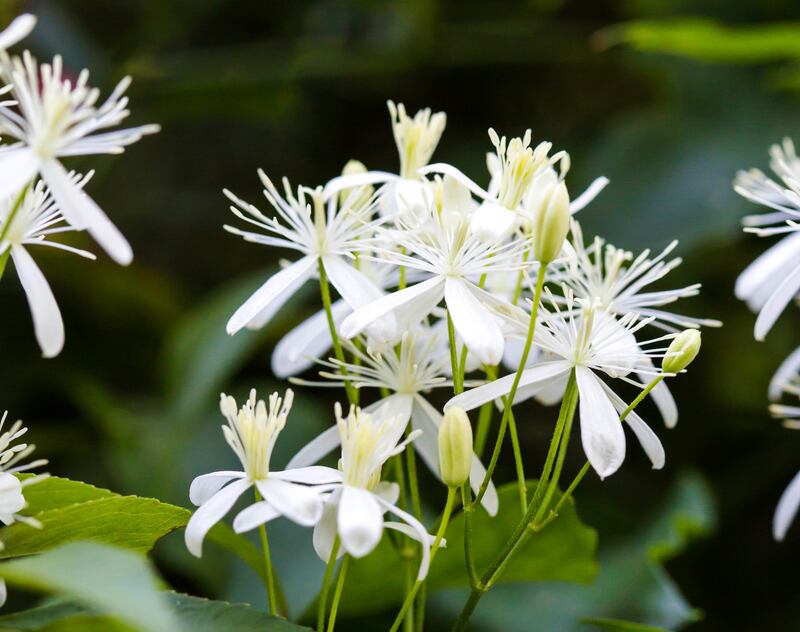
Photo Credit: Melissa McMasters / Flickr / CC BY 2.0
If you’re looking for a native plant to cover a fence or climb a pergola, the Virgin’s Bower is a great choice. This native perennial vine is a real showstopper with its clusters of white, star-shaped flowers that bloom from late summer to early fall. And, as the seasons change, these flowers transform into fluffy seed heads, adding a unique texture to your garden even as the temperatures start to drop.
It grows best in the Upper Peninsula’s sandy and loamy soils and cooler climate. Now, keep in mind that this plant isn’t a fan of heavy shade, nor does it enjoy basking in the full sun all day. Also, it can also spread quickly and take over other plants in the area. As such, it’s important to monitor the plant’s growth and take steps to control it if necessary, such as by pruning back the vines or removing any seedlings that sprout up in unwanted areas.
Plant type: Vine
USDA Hardiness Zone: 3 to 8
Sun: Partial sun
Soil: Organic-rich, well-drained loamy or silty soil
Duration: Perennial
Fragrance: Sweet smelling
Bloom time: July – September
Water needs: Medium to High
Mature height: 12 to 20 feet
Potential hazards: Poisonous to humans and animals
Maintenance: Medium
8. Swamp Milkweed (Asclepias incarnata)
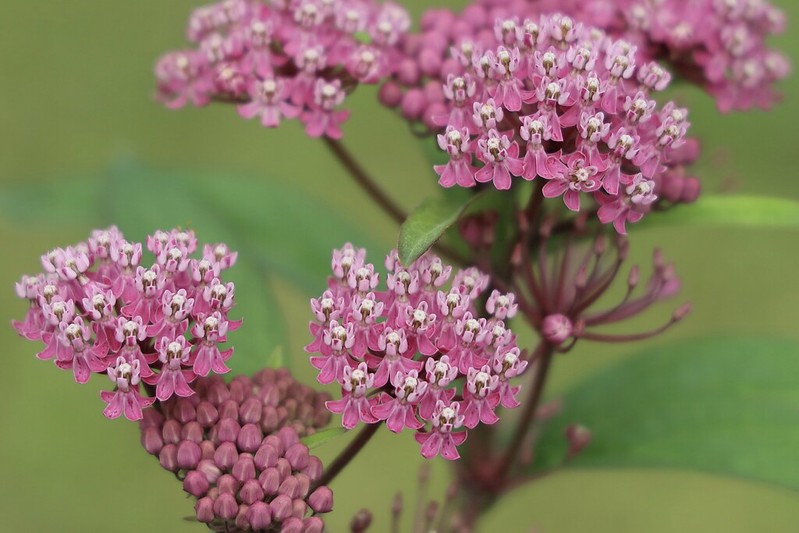
Photo Credit: Lydia Fravel / Flickr / CC BY 2.0
Swamp milkweed is a perennial herb native to Michigan’s wetland areas, from the marshes and swamps scattered throughout the Upper Peninsula to the inland wetlands and lakeshores in the Lower Peninsula. This means that while this plant is best suited for the southern and central regions of Michigan, it can still grow in the northern areas.
Swamp milkweed is well-known for its vibrant pink flowers with heart-shaped leaves, which have scalloped edges and are covered in soft hairs. It’s a great option if you’re looking to add some wildlife to your backyard – this plant is a favorite among pollinators, particularly the Monarch butterfly. However, you’ll need to keep an eye out for any potential pests, such as aphids and milkweed bugs.
Plant type: Herb
USDA Hardiness Zone: 3 to 9
Sun: Full sun to partial shade
Soil: Organically rich, slightly acidic, well-drained soil
Duration: Perennial
Fragrance: Sweet smelling
Bloom time: Midsummer to fall
Water needs: High
Mature height: 4 to 6 feet
Potential hazards: Poisonous to humans and animals in large quantities
Maintenance: Low
9. Butterfly Weed (Asclepias tuberosa)
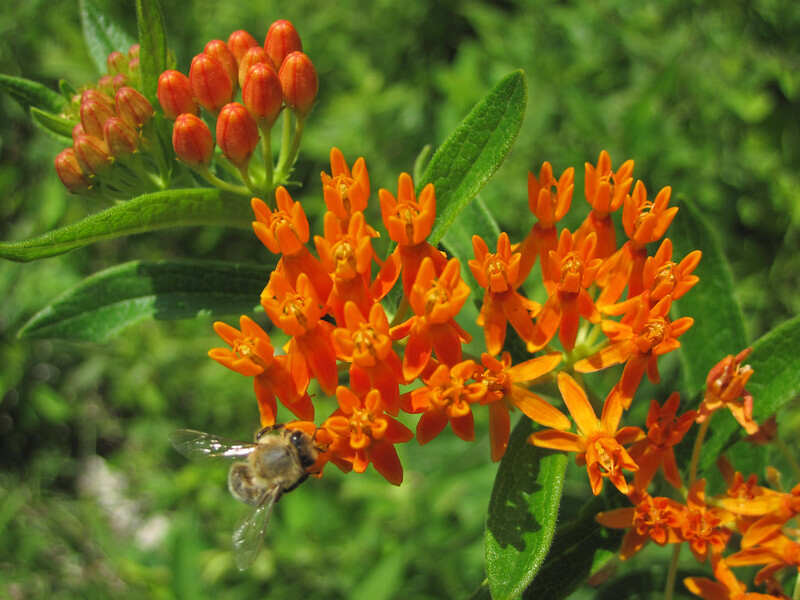
Photo Credit: James St. John / Flickr / CC BY 2.0
Butterfly weed is a great addition for yards in cities such as Ann Arbor, Kalamazoo, or Detroit,. The southern Lower Peninsula‘s climate, with its milder winters and longer growing seasons, provides an ideal environment for this plant to thrive. It can adapt to a wide range of growing conditions: for example, while it prefers full sun exposure, it can tolerate partial shade. It can also grow in different soil types, including sandy, loamy, and clay soils.
One of the primary reasons to include butterfly weed in your Michigan garden is its amazing benefit for pollinators. Like the swamp milkweed, this plant plays a critical role in the life cycle of the Monarch butterfly. It provides both a nectar source for adult butterflies and a host plant for their larvae. However, it can be slow to establish itself, especially if it’s grown from seed. It may take a few years before the plant reaches its full height and produces an abundance of flowers.
Plant type: Perennial herb
USDA Hardiness Zone: 3 to 9
Sun: Full sun to partial shade
Soil: Well-drained dry to mid-range soil moist. Loam, sand, or clay
Duration: Perennial
Fragrance: Sweet vanilla fragrance
Bloom time: May – September
Water needs: Low
Mature height: 2 to 3 feet
Potential hazards: Poisonous to humans and pets
Maintenance: Low
10. Black-Eyed Susan (Rudbeckia hirta)

Photo Credit: grassrootsgroundswell / Wikimedia Commons / CC BY 2.0
Black-eyed Susans are a common sight in Michigan’s meadows, fields, and along roadside ditches, with their bright yellow petals and dark chocolate centers. They will grow well statewide: they can thrive in a wide range of soil types, including clay-heavy soils found in areas like Oakland County. Plus, those living near Lake Michigan or Lake Huron will appreciate their ability to tolerate occasional salt spray from the lakes.
The ideal growing conditions for black-eyed Susans include plenty of sunlight, but the good news is that they’re quite adaptable. While these hardy wildflowers prefer full sun, which means at least six hours of direct sunlight per day, they can also tolerate some partial shade. However, like common boneset, they can quickly become invasive. You’ll need to stay vigilant in removing unwanted seedlings and managing their growth.
Plant type: Flower
USDA Hardiness Zone: 3 to 9
Sun: Full sun. Can tolerate some partial shade
Soil: Dry, moist, well drained soils.
Duration: Annual , Perennial, or Biennial depending on growing conditions
Fragrance: Sweet
Bloom time: Early summer to early fall (Jun – Sept)
Water needs: Medium
Mature height: 1 to 3 feet
Maintenance: Low. During its first season, it should be irrigated with only one inch of water per week – once established, it’ll be drought-resistant.
How to Choose Native Plants for Your Michigan Yard
Choosing the right native plants for your Michigan yard can transform your outdoor space into a flourishing sanctuary that supports local wildlife and requires minimal maintenance. However, to achieve this, it’s essential to consider a few factors before making your selection.
Here are some key points to keep in mind:
- Assess your yard’s conditions: Start by observing the characteristics of your lawn, such as sunlight exposure, soil type, and drainage. Understanding your yard’s ecosystem will help you select native plants that are best suited to your specific conditions, ensuring their optimal growth and health.
- Know your USDA hardiness zone: Michigan spans USDA hardiness zones 4 through 6, so make sure to choose native plants that can withstand the typical temperature fluctuations within these areas.
- Think about how the plants will look in your landscape: Some may serve as focal points, while others may work best as groundcovers or border plants.
- Consider how much time you want to spend on maintenance: Keep in mind that while some native plants require little to no upkeep, others may need regular pruning, deadheading, or dividing to promote healthy growth and prevent overcrowding.
FAQ About Native Michigan Plants
What plants are native to Detroit?
There are plenty of Detroit native plants. Some of the best options include:
- Trembling Aspen (Populus tremuloides)
- Little bluestem (Schizachyrium scoparium)
- Yellow Coneflower (Ratibida pinnata)
Many of the plants we’ve mentioned on this list are also native to Detroit, such as:
- Black-Eyed Susan (Rudbeckia hirta)
- Butterfly Weed (Asclepias tuberosa)
- Common Boneset (Eupatorium perfoliatum)
What plants are native to Michigan’s Upper Peninsula?
The Upper Peninsula of Michigan is home to various native plants, such as:
- Virgin’s Bower (Clematis virginiana)
- American Elderberry (Sambucus canadensis)
- Sugar Maple (Acer saccharum).
For more information on specific native plant species in the Upper Peninsula, you can refer to Michigan’s University Cooperation Extension Upper Peninsula native plant list.
What plants are native to Southwestern Michigan?
You can find a wide range of plants native to the southwestern region of Michigan. Some examples include:
- Wild Columbine (Aquilegia canadensis)
- Blue Cohosh (Caulophyllum thalictroides)
- Wild Geranium (Geranium maculatum)
- Jack-in-the-Pulpit (Arisaema triphyllum)
- Swamp Milkweed (Asclepias incarnata)
- Big Bluestem (Andropogon gerardii)
What trees and shrubs are native to Michigan?
Trees and shrubs native to Michigan include:
- Basswood
- Red Maple
- Northern Bush Honeysuckle
- White Oak
- Red Elderberry
- Common Buttonbush
- Nannyberry
- Serviceberry
- Flowering Dogwood
Where to Find Native Plants in Michigan
One of the best ways to source these plants is by visiting local nurseries that specialize in native Michigan flora. If you’re not sure where to start, the Michigan Master Gardener Association provides a comprehensive list of native plant suppliers across the state.
However, incorporating native plants into your landscape is just one aspect of creating a beautiful and thriving outdoor space. Selecting the right Michigan grass type for your yard is also essential for a healthy, lush lawn that complements your native plants. Low-maintenance landscaping techniques, such as hardscaping and mulching, can also help encourage a beautiful and sustainable outdoor space.
Now, while you might be tempted to roll up your sleeves and do everything yourself, let’s face it; some things are better left to the pros. From regular mowing and trimming to fertilization, a lawn care pro near you can handle the job. We have trusted pros in Detroit, Grand Rapids, and other cities across the state.
Main Image Credit: Virgin’s Bower / Under the same moon… / Flickr / CC BY 2.0